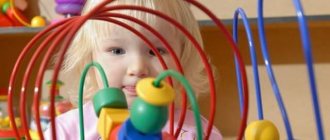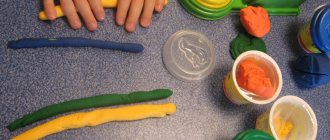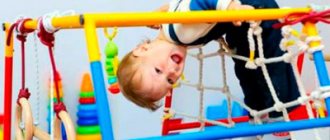MAGAZINE Preschooler.RF
BASICS OF OBJECT AND GAME ACTIVITY IN PRESCHOOL CHILDRENSubject activity is the leading activity of early childhood. Important new developments in early childhood include the child’s mastery of objective activities. Its prerequisites were formed in infancy.
The transition to object-based activity is associated with the development of a new attitude in the preschooler to the world of objects. Objects begin to appear to him not only as objects convenient for manipulation, but also as things that have a specific purpose and a specific way of use. The discovery of the purpose of objects distinguishes the object-based activity of a young child from the manipulative activity of an infant. The functions of things and objects are revealed to the child by an adult. It is he, the adult, who can provide knowledge about the purpose of objects and show techniques for their use, participating in the child’s activities as an organizer, assistant and senior partner.
An important role in the mastery of objective activity is play activity, which contributes to the fact that objective activity acquires leading status at an early age.
One of these common interpretations is the definition of the psychological concept of “activity” through the concept of “activity” . Since activity and objective activity (as we will try to analyze and prove in further research) are completely irreducible and not deducible from each other, realities and categories, but, at the same time, in psychological works are constantly connected and interdependent, we believe it is necessary to show them meaningful difference and, thereby, justify the limitations of activity and the prospects of substantive activity.
According to the periodization of mental development existing in Russian psychology, objective activity is leading at an early age. In the process of this activity, mastery of socially developed ways of acting with objects occurs.
Tool actions are formed in children gradually; mastering them requires certain efforts from children, since it presupposes a very specific, strictly fixed way of using objects.
Object-tool activity is leading in early childhood, ensuring the development of all aspects of the child’s life.
The influence of objective activity on the mental development of a child. Objective activity contributes to the development of mental processes.
Objective activity also determines the content of the child’s communication with adults.
Within the framework of objective activity, a new type of activity is being formed - a procedural game. The assimilation of socially developed ways of acting with objects is included in the system of human relations, which the child begins to understand in the course of real object-practical interaction with adults.
For children of primary preschool age, completing game tasks brings great pleasure. While playing, the child practices various actions. With the help of adults, he masters new, more complex movements.
At early preschool age, the requirement for mandatory targeted education of motor (physical) qualities is not yet put forward. However, changing game situations and game rules force a small child to move with greater speed in order to catch up with someone, or to quickly hide in a pre-designated place (house, nest) so as not to be caught, deftly overcome elementary obstacles (climb under a rope, without touching them, run between the pins without knocking over any, be sure to run to a certain place, etc.).
Thus, already in early preschool age, outdoor games are a means not only for the development of movements, but also for developing such qualities as dexterity, speed, and endurance.
Outdoor games create an additional opportunity for teacher to communicate with children. The teacher tells and explains to the children the content of the games and their rules. Kids remember new words, their meaning, and learn to act in accordance with instructions.
The activity of children in games depends on a number of conditions: the content of the game, the nature and intensity of the movements in it, the organization and methodology of its implementation, as well as the preparedness of the children.
In the process of play activities, the child acquires communication skills. He learns to take initiative, coordinate his actions, allowing him to maintain communication with his peers. In the future, gaming activities provoke longer communication. In the process of play activities, the child acquires communication skills. He learns to take initiative, coordinate his actions, allowing him to maintain communication with his peers. In the future, gaming activities provoke longer communication. Role-playing games contribute to the development of memory and imagination, and the child also learns to regulate his behavior.
Initially, interest in drawing and design is also associated with play activities, aimed at the process of creating a drawing. Only in middle and older age does the result itself—the drawing—become important for the child. The initial stage of educational activity takes place in close conjunction with play activity.
| Next > |
Main settings
The objective activity of a young child can have a developmental effect only through cooperation with adults. They are the carriers of methods of action and cultural means for a little person, as well as a source of discovering new meanings of his activity. Initially, the child performs certain manipulations on behalf of an adult and while being next to him. This confirms the joint focus of such work.
In this regard, in the child’s objective activity the following parameters of its level of development can be distinguished:
- Operating. This parameter is a direct characteristic of the actions being performed. Its indicators are such types of actions with objects as manipulative (specific and non-specific), as well as the actual object, culturally fixed ones.
- Need-motivational. This parameter indicates the level that the child has reached in his cognitive activity. Its indicators are the child’s interest in objects, his desire to examine them, as well as actions with them, emotional involvement in such activities and persistence.
- Communication with adults during objective activities. The degree of acceptance of support and help from others is an important indicator of the child’s potential capabilities.
Indicative actions
There are three stages in the development of objective activity. The first of them is observed in babies 5-6 months old. This stage represents subject manipulations. By 7-9 months they are transformed into indicative actions.
At first, all manipulations with objects in a child are carried out without considering their properties. The baby treats whatever comes into his hands equally. He sucks on a toy or any other object, waves it, taps it, etc. At the same time, he also examines what is in his hands, moves it from place to place and repeatedly repeats the same movement. And only a little later he begins to develop specific manipulations. The child not only notices, but also uses the features of objects, their most simple properties. An example of such indicative actions is stacking one object on top of another, threading a toy through the bars of the playpen. Babies also love to crumple paper and rattle with rattles. Moreover, their attention is attracted by objects created not only by man, but also by nature - sand, pebbles, water, etc.
The subject activity developing at this stage is one of the options for exploratory behavior, which manifests itself thanks to the child’s curiosity and his cognitive activity. By conducting experiments on objects in the surrounding world, the baby extracts information about them and learns to establish existing connections.
Exploratory behavior begins to develop most intensively after a little person learns to move independently, gaining access to various objects. And here the child’s communication with adults is especially important. They are entrusted with the task of organizing the child’s objective activities. Adults must create the environment necessary for the development of a little person, attract his attention to new objects, support and encourage his curiosity.
During early childhood, exploratory behavior is constantly improving. At the same time, it remains one of the most important components of creative and cognitive development not only during this period, but also in the future. By experimenting, the child gets real pleasure. He begins to feel like a subject of ongoing events and a source that caused changes in the surrounding reality.
The concept and essence of the game. Theory of play activity in domestic pedagogy and psychology
A wide, immediately inaccessible circle of reality can be mastered by a child only in play, in a playful form. This process of overcoming the past world through play actions in this world contains both play consciousness and play ignorance.
Play is a creative activity, and like any real creativity, it cannot do without intuition.
In the game, all aspects of a child’s personality are formed, significant changes occur in his psyche, which prepare him for the transition to a new, higher stage of development. This explains the enormous educational potential of play, which psychologists consider the leading activity of preschool children.
A special place is occupied by games created by children themselves - they are called creative or role-playing games. In these games, preschoolers role-play everything that they see around them in the lives and activities of adults. Creative play most of all shapes a child’s personality and is therefore an important means of education.
The game is a reflection of life. Everything here is “as if”, “make-believe”, but in this conditional environment created by the child’s imagination, there is a lot of reality: the actions of the players are always real, their feelings and experiences are real, sincere. The child knows that the doll and the bear are just toys, but he loves them as if they were alive, he understands that he is not a “righteous” pilot or sailor, but feels like a brave pilot, a brave sailor who is not afraid of danger, truly proud of his victory.
Imitating adults in play is associated with the work of the imagination. The child does not copy reality, but combines various impressions of life with personal experience.
Children's creativity is manifested in coming up with an idea for a game and finding means to implement it. How much ingenuity is needed to decide what trip to take, what ship or plane to build, what equipment to prepare! In the game, children simultaneously act as playwrights, prop makers, decorators and actors. However, they do not nurture your idea and do not prepare to play the role of actors for a long time. They play for themselves, expressing their own dreams and desires, thoughts and feelings that they have at the moment.
Therefore, the game is always improvisation.
Play is an independent activity in which children first interact with peers. They are connected by a common goal, joint efforts to achieve it, common interests and experience.
Children choose the game themselves and organize it. But at the same time, in no other activity are there such strict rules, such conditioning of behavior as here. Therefore, the game teaches children to subordinate their actions and thoughts to a specific goal, and helps to develop sense of purpose.
In the game, the child begins to feel like a member of the team, and fairly evaluates the actions and actions of his comrades and his own. The teacher’s task is to direct the players’ attention to goals that evoke common feelings and actions and contribute to the establishment of relationships between children based on friendship, justice and mutual responsibility.
The first position, which determines the nature of the game, states that the motives of the game lie in various experiences that are significant aspects of reality for the player. A game, like any other human activity that is not a game, is motivated by an attitude towards goals that are significant to a person.
In the game, only those actions are performed whose goals are significant for a person due to their own internal content. This is the main feature of gaming activity and this is its main fascination.
The second - characteristic - feature of the game is that the game action implements the diverse motives of human action and, realizing emerging goals, is not tied to the means or methods of action by which these actions are carried out in a non-game practical plan.
Play is an activity in which the contradiction between the rapid growth of the child’s needs, which determines the motivation of his activity, and the limitation of his operational capabilities is resolved. Play is a form of realizing the child’s needs and requirements within the limits of his capabilities.
The next, outwardly most striking distinctive feature of play, which actually follows from the above-mentioned internal features of play activity, is the opportunity, which is a necessity for the child, within the limits determined by the meaning of the game, to replace objects that function in the corresponding non-play practical action with others that can serve for a play action (stick - horse, chair - car, etc.). The ability to creatively change reality is formed only in the game. This ability is the main value of the game.
Does this mean that playing in an imaginary situation is an escape from reality? Yes and no. In the game there is an escape from reality, but there is also an intrusion into it. Thus, there is no escape, no escape from reality into a seemingly special, imaginary, fictitious, unreal world. Everything that the play lives in and that is embodied in the action is taken from reality. The play goes beyond the situation, abstracts from some aspects of reality in order to reveal others more deeply.







